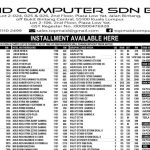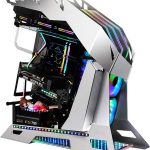Discover The Ultimate Computer All Hardware Names: Uncover Your Perfect Setup Now!
Computer All Hardware Name
Introduction
Welcome, Readers! Today, we will be discussing the comprehensive list of computer hardware components. In this article, we will explore the various parts that make up a computer system, their functions, and how they work together to provide us with the technology we rely on. Whether you are a tech enthusiast, a student studying computer science, or simply curious about the inner workings of your device, this article will give you a detailed overview of computer all hardware name.
1 Picture Gallery: Discover The Ultimate Computer All Hardware Names: Uncover Your Perfect Setup Now!

Before we delve into the specifics, let’s first understand what computer hardware is. Computer hardware refers to the physical components of a computer system, such as the processor, memory, storage devices, and peripherals. These components work together to process data, execute commands, and perform various tasks.
Now, let’s proceed to explore the different categories of computer hardware and their respective components.
1. Central Processing Unit (CPU) 📊

Image Source: computerinfobits.com
The CPU, often referred to as the brain of the computer, is responsible for executing instructions and performing calculations. It consists of an arithmetic logic unit (ALU), control unit, and cache memory.
2. Memory 📊
Memory in a computer system refers to the storage space used to temporarily hold data and instructions that the CPU requires to process. This includes Random Access Memory (RAM) and Read-Only Memory (ROM).
3. Storage Devices 📊
Storage devices are responsible for long-term data storage. Examples include hard disk drives (HDD), solid-state drives (SSD), and optical drives. These devices allow us to store and retrieve data even when the computer is turned off.
4. Motherboard 📊
The motherboard is the main circuit board of a computer. It houses the CPU, memory, and other essential components. It acts as a hub that connects all the hardware components, allowing them to communicate and work together.
5. Graphics Processing Unit (GPU) 📊
The GPU is responsible for rendering images, videos, and animations. It is particularly important for graphics-intensive tasks such as gaming, video editing, and 3D modeling.
6. Power Supply Unit (PSU) 📊
The PSU is responsible for supplying power to all the components of a computer. It converts the AC power from the wall outlet into DC power that the computer can use.
7. Input and Output Devices 📊
Input devices allow users to enter data or commands into the computer. Examples include keyboards, mice, and scanners. Output devices, on the other hand, display or provide the results of the computer’s processing. Examples include monitors, printers, and speakers.
What is Computer All Hardware Name?
Computer All Hardware Name refers to the complete list of hardware components that make up a computer system. It includes the CPU, memory, storage devices, motherboard, GPU, PSU, and input/output devices.
Who Should Know About Computer All Hardware Name?
Understanding computer hardware is essential for anyone working in the field of technology or computer science. It is particularly useful for computer technicians, system administrators, and software developers. However, even for regular users, having a basic understanding of computer hardware can help troubleshoot issues and make informed decisions when purchasing or upgrading their devices.
When Was Computer All Hardware Name First Introduced?
Computer hardware has been evolving since the advent of the first electronic computers in the mid-20th century. The modern computer hardware we are familiar with today has its origins in the 1970s and has been constantly evolving ever since.
Where Can You Find Computer All Hardware Name?
Computer hardware components can be found in various places, including computer stores, online retailers, and even specialized electronic component stores. They are widely available and can be purchased individually or as part of pre-built computer systems.
Why is Computer All Hardware Name Important?
Computer hardware is the foundation of any computer system. Without the proper hardware components, a computer would not be able to function. Understanding computer hardware is crucial for troubleshooting, upgrading, or building a computer system tailored to specific needs.
How Does Computer All Hardware Name Work Together?
Computer hardware components work together by communicating with each other through various interfaces and protocols. The CPU coordinates the execution of instructions and data transfer between different components, while the motherboard acts as a central hub that facilitates this communication. Each component performs its specific function, contributing to the overall operation of the computer system.
Advantages of Computer All Hardware Name
1. Flexibility: Computer hardware can be customized and upgraded to meet specific requirements, allowing users to adapt their systems to changing needs.
2. Performance: The right combination of hardware components can significantly improve the performance and speed of a computer system, enabling faster processing and better efficiency.
3. Compatibility: Computer hardware is designed to be compatible with various software applications, ensuring smooth operation and optimal performance.
4. Reliability: High-quality hardware components are built to withstand rigorous usage and provide reliable performance, minimizing the risk of system failures.
5. Expandability: Computer hardware allows for future expansion and upgrades, extending the lifespan of the system and ensuring compatibility with emerging technologies.
Disadvantages of Computer All Hardware Name
1. Cost: High-performance hardware components can be expensive, making it challenging for budget-conscious users to afford the latest technologies.
2. Complexity: Understanding and troubleshooting computer hardware can be complex, requiring technical knowledge and expertise.
3. Compatibility Issues: Incompatibilities between hardware components or with software applications can lead to system instability or limited functionality.
4. Power Consumption: Powerful hardware components consume more power, leading to higher energy consumption and increased electricity bills.
5. Obsolescence: Computer hardware becomes outdated quickly, as technology advances rapidly. This necessitates frequent upgrades or replacements to keep up with evolving requirements.
Frequently Asked Questions (FAQs)
1. Can I upgrade my computer’s hardware components?
Yes, most computer hardware components can be upgraded to improve performance or add new features. However, compatibility and technical knowledge are essential considerations when upgrading hardware.
2. How long do computer hardware components typically last?
The lifespan of computer hardware components varies depending on factors such as usage, quality, and technological advancements. On average, components like CPUs and GPUs can last 5-10 years, while storage devices may last 3-5 years.
3. Is it necessary to have the latest hardware for everyday computer usage?
No, having the latest hardware is not necessary for everyday computer usage. Most tasks, such as web browsing, word processing, and multimedia playback, can be handled by slightly older hardware without significant performance issues.
4. How can I troubleshoot hardware issues on my computer?
When troubleshooting hardware issues, start by checking connections, updating drivers, and running diagnostic tools. If the issue persists, professional assistance may be required to identify and resolve the problem.
5. Can I build my own computer from scratch?
Yes, building a computer from scratch is possible and can be a rewarding experience. It allows for customization, cost savings, and a better understanding of the inner workings of a computer system. However, it requires technical knowledge and research to ensure compatibility and proper assembly.
Conclusion
In conclusion, computer hardware is a crucial aspect of any computer system. It encompasses various components that work together to provide the functionality we rely on daily. Understanding the different hardware components, their functions, advantages, and limitations can empower users to make informed decisions when it comes to troubleshooting, upgrading, or building a computer system. Whether you are a professional in the field or simply an enthusiast, knowledge of computer all hardware name is essential in today’s technology-driven world.
Final Remarks
Thank you for joining us on this exploration of computer all hardware name. We hope this article has provided you with valuable insights into the world of computer hardware. Remember to stay updated with the latest advancements in technology, as the field of computer hardware continues to evolve at a rapid pace. If you have any further questions or require assistance, feel free to reach out to our team of experts. Happy computing!
This post topic: Electronics

